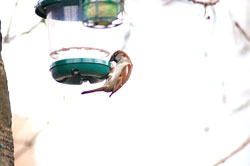Tamron AF 70-300mm f/4-5.6 Di LD Macro
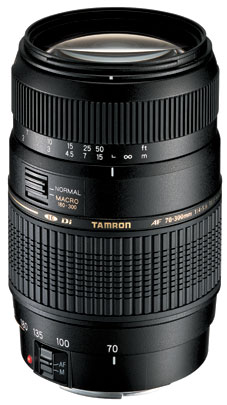 |  Lens guru, Gary Wolstenholme tests the Tamron 70-300mm zoom lens. Is it worth the relaively low price or should it be relegated to the bargain bin? |
Often after purchasing a camera complete with standard kit lens, many will look for a telephoto zoom to extend their reach when photographing distant subjects. This Tamron is aimed at budget-conscious photographers looking for a lens in this range. It costs around £132 and adds in a useful macro feature which enables up to half life-size magnification at 300mm. It also includes Low Dispersion glass in its design, which should provide adequate correction for colour fringing. The low price makes this amongst the cheapest on offer in this range.
Sigma currently offer a few lenses in this range. The cheapest costs around £127 and has similar Macro functionality. The next lens up in their line is very similar, but costs £177 as it is an Apochromatic lens, which offer better correction for colour fringing than the standard Sigma, which should result in sharper pictures. Finally, at the top of Sigma's range is their Optically Stabilised 70-300mm, which we reviewed in January 2010:
Sigma 70-300mm f/4-5.6 DG OS
It costs around £310 and offers optical stabilisation to correct for camera shake, but sacrifices the Macro functionality.
Manufacturer's own offerings vary wildly in price depending on their intended market. Canon offer a basic 75-300mm lens with macro feature for around £210 and an image stabilised 70-300mm for around £420. there is also their rather exotic Diffractive optics version, which is around half the size of most of these 70-300mm lenses, has an image stabiliser and costs a whopping £1137!
Sony currently offer two lenses covering this range – a basic 75-300mm which costs around £180 and one with silent focusing and better build quality for £680, neither of which have a Macro function. Nikon only currently offer one lens that covers this range, which offers Vibration Reduction, silent focusing, but no macro function.
Tamron AF 70-300mm f/4-5.6 Di LD Macro: Handling and features
This lens is very lightweight, but without feeling flimsy. The fit and finish of the materials used is good and a metal lens mount has been used, which will stand up to many lens changes.
Focus is powered by a standard built-in micro-motor, which does the job, although not blindingly quickly. The lens tends to hunt around a little at the longer end of the zoom, but seems to lock on just fine in most conditions at 70mm. The focus ring rotates during focusing and there's no way to disengage it during auto-focus, which is about what I'd expect for this level of lens. The front element rotates during focus as well, which may cause problems if using the lens with a polariser. The resistance of the zoom mechanism is just right for allowing accurate composition, without risking zoom creep.
To make use of the Macro function, the zoom first needs to be set between 180mm and 300mm, which is marked with a gold stripe. Than the switch on the body of the lens can be switched to macro, which is also gold coloured. Once this action has been completed, you're free to use the extended close-focus range indicated by another gold stripe. This process takes a bit of getting used to, but once you do it's fairly straightforward switching between normal and macro focusing.
With your subject nearly a metre from the plane of focus, it makes it easy to take frame-filling shots of things that are not very large. The large working distance may make this lens suitable for those looking for a budget introduction to shooting insects or other small things that may get spooked if you get too close.
Tamron AF 70-300mm f/4-5.6 Di LD Macro: Performance
For this review, the lens was tested on a 12Mp Nikon D700 using Imatest.
Tamron's 70-300mm gave quite pleasantly surprising results during testing. At f/4 and 70mm, the centre resolution is already very good and stopping down to f/8 raises the resolution to excellent levels.
As with most telephoto zoom lenses, the resolution drops as you zoom in, but this budget lens still holds its own well, producing good to very good resolution at all apertures until diffraction robs the lens of contrast and sharpness below f/22. Shooting at these apertures would be a creative decision though.
At 300mm the resolution is still more than acceptable at f/5.6. Stopping down to f/8 yields images with good enough resolution to please all but the most demanding photographers.
| Resolution at 70mm |
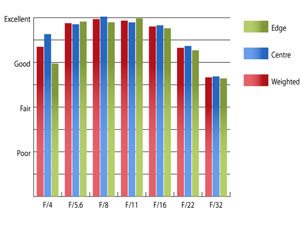 |
| Resolution at 135mm |
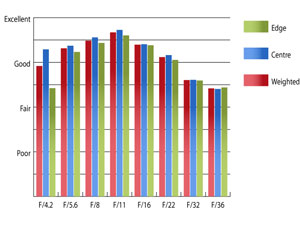 |
| Resolution at 300mm |
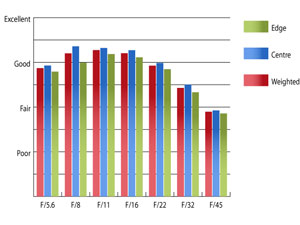 |
Chromatic Aberrations are kept in check at the shorter end of the zoom range, barely covering half a pixel-width up to 135mm. At 300mm, CA levels increase, just exceeding 0.9pixel widths, which may be visible under close-inspection, but will not cause too many issues for most.
| Chromatic Aberrations at 70mm |
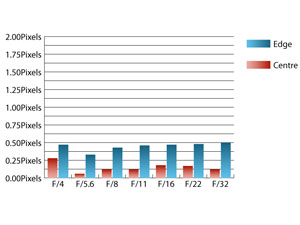 |
| Chromatic Aberrations at 135mm |
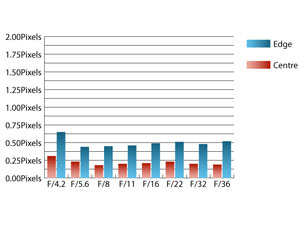 |
| Chromatic Aberrations at 300mm |
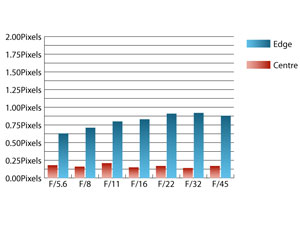 |
Light falloff towards the corners is well controlled, with the far corners onl being 0.8 stops darker than the image centre at 70mm and f/4. Illumination appears even by f/5.6. At 300mm the corners darken a little bit more at f/5.6 and are one whole stop darker than the image centre. Just like at 70mm things even up b stopping down one stop to f/8.
At 70mm, distortion barely registers in Imatest, which is very well controlled for a zoom. However at 300mm pincushion distortion rises to a more noticeable 2.19%. The distortion pattern is even, and should be easy to correct with basic lens tools in your image editing software.
Flare and ghosting performance is very good with this lens. Strong light sources in the frame cause a tiny amount of ghosting and flare, but much less than many other lenses at this price point. Light sources outside of the frame barely affect the image at all and the supplied circular hood does an excellent job of shading the front element.
 | DxOMark provides objective, independent, RAW-based image quality performance data for lenses and digital cameras to help you select the best equipment to meet your photographic needs. Visit the DxOMark website for tests performed on the Tamron AF 70-300mm f/4-5.6 Di LD Macro. |
Tamron AF 70-300mm f/4-5.6 Di LD Macro: Verdict
For a budget lens, the Tamron 70-300mm performs surprisingly well, producing images with excellent resolution at shorter focal lengths. The Macro feature is a useful addition, offering an introduction to close-up photography that should yield excellent results if used within its limitations.
Overall I feel the Tamron is an excellent choice for those looking for a budget telephoto addition to the kit lens supplied with their camera.
Tamron AF 70-300mm f/4-5.6 Di LD Macro: Pros
 Lightweight
Lightweight Resolution at shorter focal lengths
Resolution at shorter focal lengths Macro feature
Macro feature Good value for money
Good value for money Good resistance to ghosting and flare
Good resistance to ghosting and flareTamron AF 70-300mm f/4-5.6 Di LD Macro: Cons
 Slow autofocus
Slow autofocus Rotating front element may make it difficult to use a polariser
Rotating front element may make it difficult to use a polariser| FEATURES |  |
| HANDLING |  |
| PERFORMANCE |  |
| VALUE |  |
| OVERALL |  |
Tamron AF 70-300mm f/4-5.6 Di LD Macro: Lens specification
| Price | £132 |
| Contact | www.tamron.co.uk |
| Filter size | 62mm |
| Format | Full frame/FX |
| Construction | 13 elements in 9 groups |
| Angle-of-view | 34°21’-8°15’ |
| 35mm equiv. length (on APS-C body) | 105-300mm |
| Internal focusing | No |
| Image stabilisation | No |
| Minimum focusing | 150cm (normal), 90cm (macro) |
| Maximum aperture | f/4-5.6 |
| Minimum aperture | f/32-45 |
| Weight | 435g |
| Size | 116.5x76.6mm |
| In the box | Lens hood |
The Tamron AF 70-300mm f/4-5.6 Di LD Macro costs £132 and is available from Warehouse Express here:
Tamron AF 70-300mm f/4-5.6 Di LD Macro Nikon fit
Tamron AF 70-300mm f/4-5.6 Di LD Macro Canon fit
Add your message
Login required
Please login here or if you've not registered, you can register here. Registering is safe, quick and free.
Please login here or if you've not registered, you can register here. Registering is safe, quick and free.
photodo Stats
1102 lenses
428 MTF tests
74 in-depth photodo reviews
100+ users join each day
Help the lens community by reviewing or rating a lens today via our lens search
428 MTF tests
74 in-depth photodo reviews
100+ users join each day
Help the lens community by reviewing or rating a lens today via our lens search
Latest Lens Reviews
- Chinon 28mm f/2.8 Vintage Lens Review
- Canon EF 70-200mm f/4L IS II USM Lens Review
- Samyang AF 85mm f/1.4 EF Review
- Sigma 70mm f/2.8 DG Macro Art Review
- Samyang AF 24mm f/2.8 FE Review
- Meike 50mm f/1.7 Review
- Tamron 70-210mm f/4 Di VC USD Review
- Lensbaby Burnside 35mm f/2.8 Review
- Asahi Super Takumar 50mm f/1.4 Review
- Asahi Super-Multi-Coated Takumar 135mm f/3.5 Review

